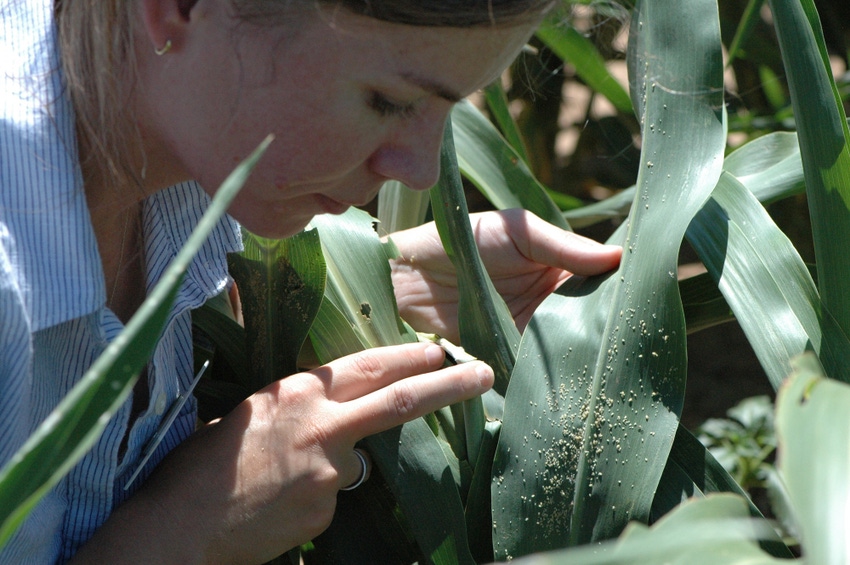August 27, 2016

Planting date may be an important consideration in dealing with sugarcane aphid infestations in grain sorghum, according to ongoing research by Texas A&M AgriLife entomologist Ada Szczepaniec.
Among other concerns, Szczepanic is looking at when the aphids are most damaging to grain sorghum and what varieties they prefer. With the support of Texas Grain Sorghum Producers, Szczepaniec is testing several different strategies to determine their effectiveness in combating this fairly new pest to the Texas Panhandle.
While sugarcane aphids are not new to Texas, last year was the first for the Texas Panhandle to see damaging infestations in sorghum, she said. The aphids attack grain and forage sorghum in the High Plains, sucking sap from plant leaves and leaving behind sticky honeydew.
One of the possible management criteria she is looking at is adjusting planting date.
“A very important integrated management approach is to plant crops earlier or later depending on the vulnerability of the different crop stages to the particular pest,” Szczepaniec said. “We are hoping that planting early may help prevent the heaviest toll on yield.”
RESEARCH NEEDED
She said, however, multiple years of research are needed before there is adequate research-based data to support that hypothesis.
“We are also testing different varieties, those we know are susceptible based on previous research, as well as some that show what we call ‘tolerance,’ These varieties can tolerate higher numbers of aphids or aphids do not increase in numbers as rapidly on these varieties compared to others.”
Szczepaniec’s experiments include testing how early planted and traditionally planted sorghum varieties with and without tolerance to sugarcane aphids affect timing of colonization and population increase of the aphids. She is also testing the use of insecticide seed treatments to evaluate how they affect sugarcane aphid pressure.
This year the sugarcane aphids arrived in the Panhandle in late July through early August, she said.
“Their populations were very slow to build up at first. We initially noted single aphids on plants likely flying in from the surrounding habitats into the sorghum fields and reproducing.”
RAPID POPULATION INCREASES
She explained sugarcane aphids have live births and exhibit what is called telescoping generations, allowing immature aphids to develop inside their not-yet-born mothers.
“What commonly happens soon after the aphids get established is an incredibly rapid increase in their populations,” Szczepaniec said. “This exponential population growth is very (difficult) for managing sugarcane aphids – 40 aphids per leaf in one week may multiply to hundreds the next week.”
The early data indicates tolerant varieties have a more gradual increase in numbers, she said.
“This means producers will have more time to catch populations of sugarcane aphids before they reach the phase of exponential increase and have time to arrange for proper insecticide applications before the aphids reach economic injury level.”
Szczepaniec stressed that it is very important to stick to thresholds before making management decisions.
BIOLOGICAL CONTROLS
“We have noticed very quickly in our infested plots that we have a tremendously robust community of biological control insects. These include of course lady beetles, lacewing larvae, parasitoid wasps, as well as syrphid fly larvae, which is not well-known but very important and very effective at suppressing aphids as well.”
If insecticides are applied too early, before aphid numbers reach the recommended threshold, they are going to eliminate these natural enemies that can do a very good job of suppressing low populations of aphids and slow down their increase, she said.
Szczepaniec said a separate research project will evaluate how different numbers of aphids affect sorghum plants at different stages of development in a controlled greenhouse experiment, which will help determine how timing of colonization affects sorghum yield.
“We are in a bit of a different situation here in the Texas Panhandle than folks down South where aphids colonize the plants early in plant development,” she said. “We start seeing them at heading, blooming and even a little bit later, depending on planting date. We will measure impact on yield when aphids start showing up and feeding on them at different stages.”
The research both in the field and in the greenhouse will be continued over several years because variability in weather and precipitation levels can affect results, Szczepaniec said.
You May Also Like




